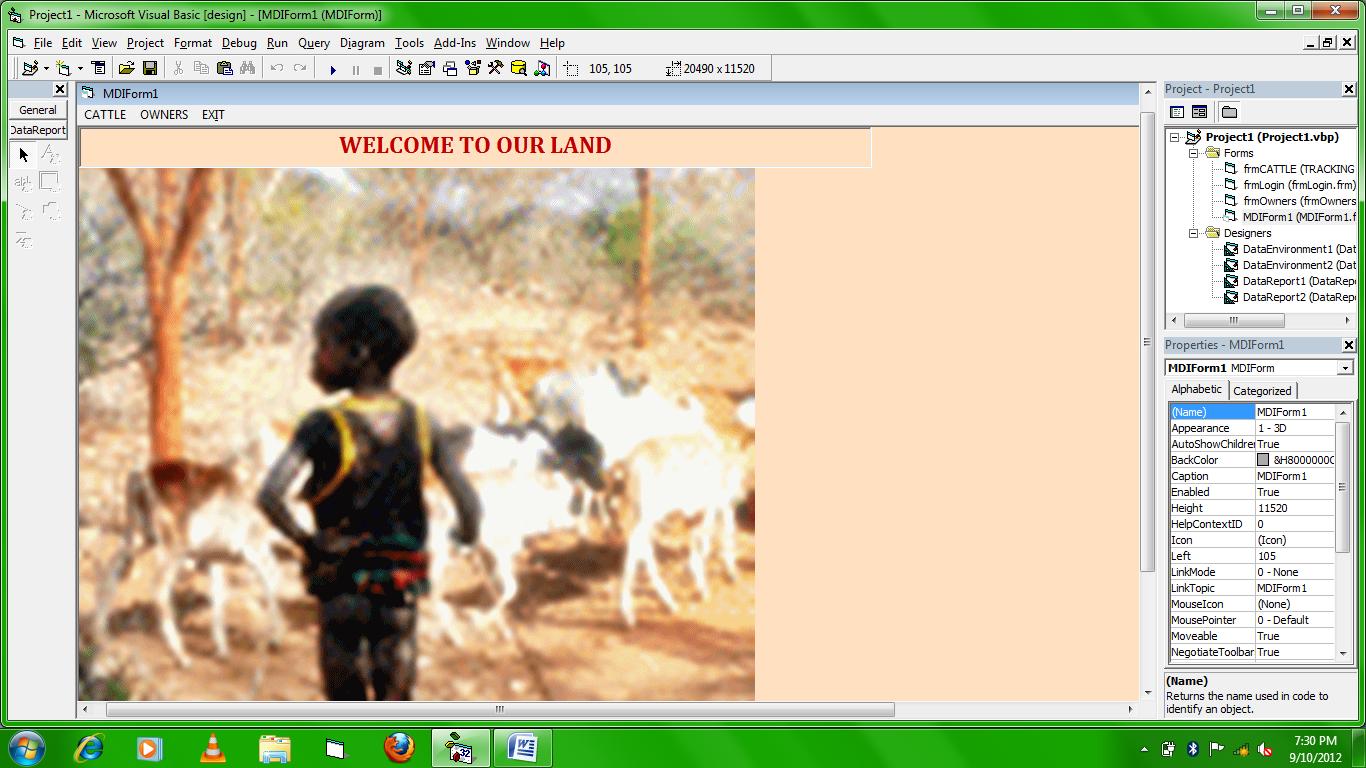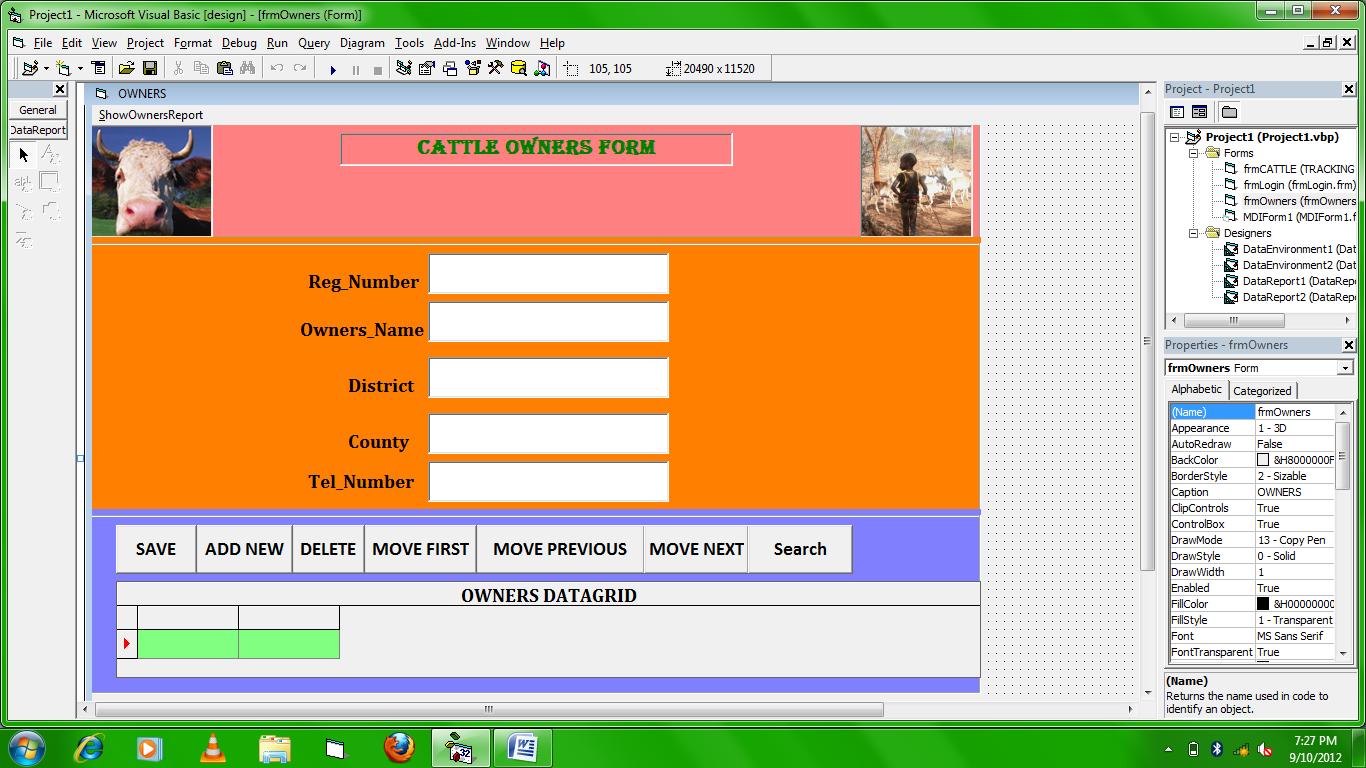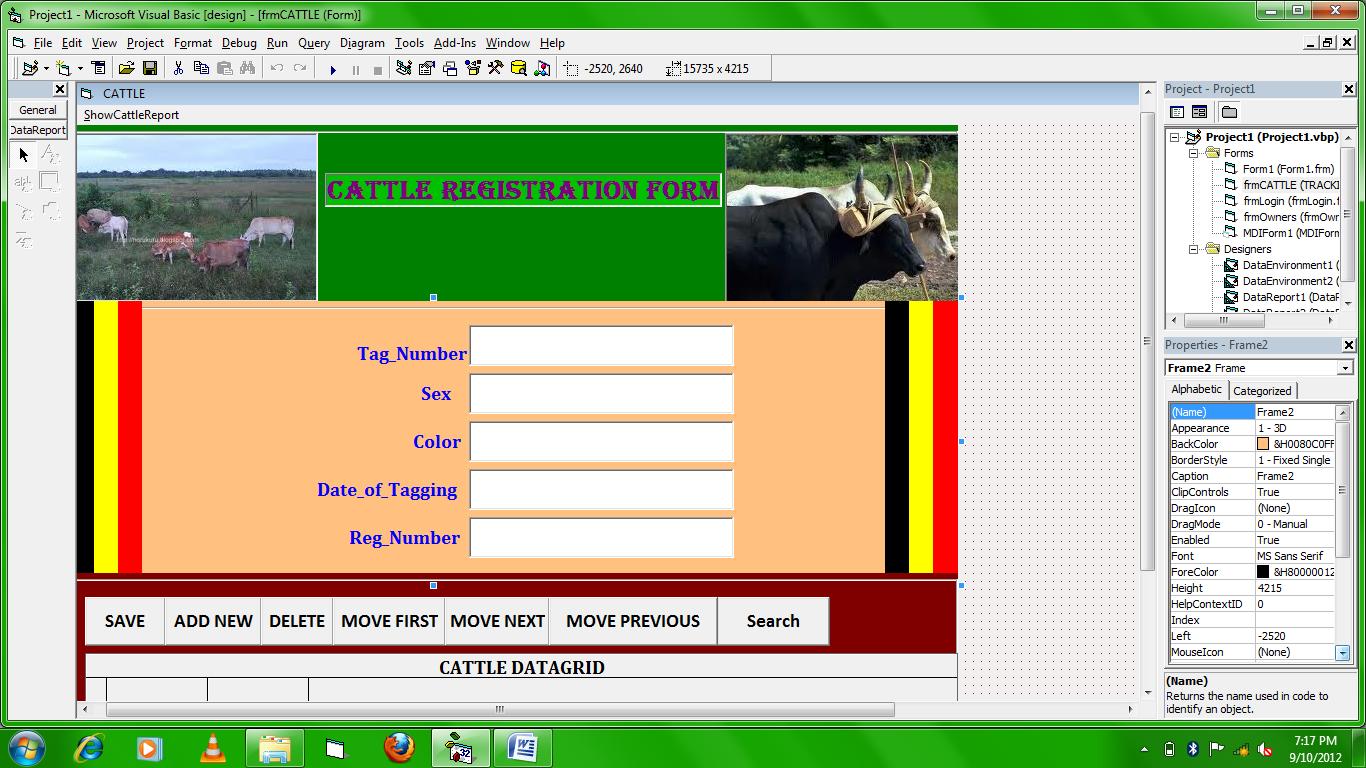www.idosr.org
©IDOSR PUBLICATIONS
Mungan and Ogigo
International DigitalOrganizationforScientific Research IDOSR JOURNAL OF COMPUTER AND APPLIED SCIENCES 8(1):9-19, 2023. ISSN: 2579-0803 Design and Implementation of a Cattle Bolus Tracking Registration System to Curb Cattle Rustling: A case study of Moroto District.
Mungan Gabriel and Ogigo EmmanuelDepartmentofComputerScience,KampalaInternationalUniversity,Uganda.
ABSTRACT
Cattle raiding is very much characteristic of early societies and is very prevalent during early century migrations. Cattle thefts, raiding and interclan conflicts are neither new nor particular to the Moroto district as a people. This study was aimed to design and implement a Cattle Bolus tracking registration system that will help the community of Moroto district to curb the problem of cattle rustling. The representation of the sample was obtained by using a population of (35) respondents out of (50) fifty The researchers employed questionnaires, interviews, observations and documentation techniques in collection of primary and secondary data. Using an introduction letter from the university, permission was granted from the district’s department of Agriculture and animal husbandry or any other recognized authority to carry out the research in the area. The researchers endeavored to approach the target respondents according to the schedules and intervals already prepared, while explaining the essence of the study and assuring the respondents of its benefits even to the community in general. The field questionnaires were summarized on a pre-planned form which facilitated data analysis later. The researchers were able to understand the problem thoroughly, examined the feasibility of the project and establishes systems requirements. In this study, we presented a simple, convenient, cost-effective, but efficient system with a user-friendly, intuitive interface. It is cost effective as less time is spent by users effecting their search and tracking for the animalsfrom wherevertheyareprovided they areregisteredand they have the bolus chip.
Keywords: Cattle theft, Moroto district, Cattle bolus, Cattle rustling.
INTRODUCTION
According to [1], the bolus measures ¾ × 2½ in. and weighs 4 to 6 oz. It can be given to a cow similarly to how some medications are delivered in bolus form down the animal's throat. The device's weightkeepsitin theanimal's rumen. The bolus communicates electronically with a receiver and/or the animal's ear tag, whichin turn retransmits information to a reader antenna. The bolus and ear tag have a coordinating 15-digit identification numberspecific to that animal. Various configurations are available that allow the bolus to record and transmit the animal's core body temperature, pH or internal gas pressure [2,3,4,5,6]. An alarm will sound if the animal is acidotic or suffering from bloat. Many cattle diseases are accompanied by a change in internal temperature, pH and pressure, Burgess
explains. If an animal is sick, the appropriate data are transmitted to alert the producer's computer or even light upthe eartag on the sickanimal forquick sortinganddoctoring [7,8,9,10]
The bolus/ear-tag combination also alerts producers by cell phone or computer when an animal is either stolen or gets out. “When the ear tag/bolus passes the geofence, or when the ear tag is cut off, alarms are programmed to communicate to the proper authorities such as the producer or sheriff,” Burgess says. The ultrahigh-frequency tracking system has a read rate of 500 animals per second. Burgess says the system can read 100% of the tagged cattle as they are transported past a reader, while loaded on a tractor trailerrolling down the highway [11,12].
www.idosr.org
According to [2],”LITS in Botswana”, the Government of Botswana introduced Livestock Identification and Trace-back System (LITS) for the electronic individual identification and registration of cattle; establishment of country of origin. This was meant to permit monitoring of diseases, traceability of beef products to the farm of origin, in fulfillment of EU export requirements. The first phase was completed in 2001. A rumen bolus is about the size of a ‘baby’ carrot and has a ceramic coating that covers a microchip with unique number. Bolus is inserted only in branded cattle that were at least three months old. Each bolus costs about US$2.50 for a newbolus, whilst a recycled onecosts US$1.45.
According to [3], cattle thefts, raiding and interclan conflicts are neither new nor particular to the Moroto district as a people. Raiding was very much characteristic of early societies and was very prevalent during early century migrations. What probably is surprising is that whereas most settled communities have abandoned intertribal raiding in modern times, the Moroto district and most pastoral communities in the Horn of Africa continue to raid with increasing levels of destruction of human lives and property.
In modern day Moroto district, early traveler’s reports indicate that livestock raiding and killing were frequent occurrences as early the 17th Century [4]. When the British first made contact with Moroto district in 1897 through Col. Macdonald s relief convoy to the Sudan, they found heavily armed groups of Moroto district who were trading in ivory. The traders were reported by Col. Macdonald to have been at the complete mercy of the Moroto district that were trading ivory for rifles, cattle and ammunitions[5]
Problem statement
Cattle thefts, raiding and interclan conflicts are neither new nor particular to the Moroto district as a people. Raiding was very much characteristic of early societies and was very prevalent during early century migrations. This is still muchpracticedinMoroto District now.
Mungan and Ogigo
Aim of the study
The research was to design and implement a Cattle Bolus tracking registration system that will help the community of Moroto district to curb the problemof cattle rustling.
Specific objectives of the study:
• To study the existing cattle tracking methods and review if they still meet the requirements.
• Analyze the requirements for the design of a more reliable cattle tracking informationsystem.
• To design a reliable cattle trackingsystem.
• To develop an information systemforthe design.
• To test the cattle tracking systemwithdummy data.
Research questions:
• What are the current cattle tracking methods used in northern Uganda?
• Do they serve the purpose of helping cattle farmers ensure proper surveillance oftheircattle?
• What are the reliable methods that they should follow to ensure proper tracking of theircattle?
Significance of study
After identifying the problem in Moroto and the neighboring districts, an online database bolus tracking system developed to solve the weaknesses in tracking the animalsmanually.
The system will help the police and the local authorities to easily locate and identifythe lostanimals.
• It will reduce the practice of cattle raidingand theft.
• It will also reduce the intertribal conflicts.
• It will help reduce the displacement of people inthearea.
• It will also help reduce on loss of life due to raidsin thearea.
• It will help to easily monitor and managediseaseoutbreak.
METHODOLOGY
Research Design (Empirical/Testing).
The researcher used explanatory, analytical, quantitative as well as qualitative research. These methods helped find out the impacts between the two variables (bolus tracking system and cattle rustling).It also explain the effects of bolus tracking system and cattle rustling.
Study Population
The study was centered on Moroto district that had a total population of 333,700; it seeked response from the Department of Agriculture and Animal Husbandry, local authority, police, and the cattle owners. The reason for choosing moroto district was based on its position and being one of the district in Karamoja region known for cattle rustling which made the researcher attracted to the area. The researcher contributes on how bolus tracking system can curb down cattle rustlingin moroto district.
Target/accessible population
The representation of the sample was obtained by using a population of (35) respondents out of (50) fifty. This intends to facilitate the attainment of objective results.
The sample will be selected from the local authority, policeand cattle owners.
Data collection
The researchers employed different techniques in collection of primary and secondarydata.
Questionnaires
• Interviews
• Observation
• Documentation
Data collection instruments
This included specific instrument that were used the data collection. In this regard, the questionnaire schedule was employed to collect data. In the case of closed ended questions, respondents were required to tick the appropriate answers.
Mungan and OgigoResearch Procedures
Using an introduction letter from the university, permission was granted from the district’s department of Agriculture and animal husbandry or any other recognized authority to carry out the research in the area. The researchers endeavored to approach the target respondents according to the schedules and intervals already prepared, while explaining the essence of the study and assuring the respondents of its benefits even to the community in general. The field questionnaires were summarized on a pre-planned form which facilitated data analysislater.
Data Analysis
The researchers were able to understand the problem thoroughly, examined the feasibility of the project and establishes systems requirements.
Assumption and Limitations
The assumption was that all the cattle in the region were to be registered such that it will be easy to enter them in the system. There were quite a number of limitations in this research and they include;
Not all animals were registered in the region
Some of the respondents were not willing to give information; they also ended up charging too much togivelittle data.
Transport was alsovery expensive
The local people in the region were blocked due to the exercise due to cultural factors.
Ethical consideration
In ethical consideration we consider the researchers’ conduct when in the field. Researcher did not use a foul language, for this will make the respondents to either refuse with the information or give you wrong information. Researcher was friendly and convincing to the respondents.
Figure 1: Application Architecture of Bolus Tracking System (BTS)
System Architecture
This gives a high level view of the new system with the main components of the system and the services they provide and how they communicate. The Cattle Bolus Tracking system is implemented using a three-tier architecture that comprises of
client and system and the Cattle, using the server, tracking management and DBMS as illustrated below. This structure ensures that owner interaction with the system is independent of storage consideration.

www.idosr.org
Context Diagram
Entercattle’sdetails trackinganimal Report Cattle detail
Mungan and Ogigo
Figure 2: System Database Design
Conceptual Database Design
After system investigation and analysis, the concept of the new system was designed and all the relevant entities involved in the system were identified.
The following entities were chosen to capture this information like client’s name, company name, the location of client in case of delivery for product, category of theproducts.
1 : 1
1 : 1
0 : * 1 : * 0 : *
Tracking system Registers
Browse
1 : 1
1 : *
Places
Clients CItsid
1 : * 0 : *
Processed
1 : 1
database system cattle details
Send request
Figure 3: Entity Relationship Diagram (ERD)
System Implementation System Testing
This involved execution of the system in order to determine whether it matches its specification and executes as per the design. The following testing strategies were deployed to carry out application testing of the system:
i) User Testing
A number of cattle owners were randomly selected to test the system pages and to commenton theusability of thesystem.
(ii) Unit Testing
Each executable component of the system was tested for the desired functionality.
(iii) Module Testing
Each executable unit page was integrated andtestedasa module.
iv) Functionality or system Testing System pages were integrated and tested as whole. The different pages were integrated to come up with one functional system which was then tested as a whole to make sure that it meets the general objectives of the project.
Sample User Interfaces
Figure 4: Main Home page on Computer


Figure 6: Cattle Page Interface

DISCUSSION
This project was successful in implementing the objectives stipulated earlier. The system offers a number of benefits to the cattle owners, local authorities and the community at large. They are able to conveniently and easily carryout the search for the lost or stolen animals.
Some of the graphical results generated fromthe systemare discussed below:
System Interfaces
Home Page Interface
This interface is the first to be shown when the police, visitor, or any other person logs on to the system. This has
different tabs leading to other different pages like owners page, cattle page (Figure 4).
Owners page Interface
Owners’ page interface gives the details of the cattle owners; and it is the page where the cattle owners can enter all their necessarydetails (Figure5).
Cattle Page Interface
Cattle page displays the cattle details; this is the page where the cattle’s details can becapturedfrom (Figure6).
www.idosr.org
and OgigoLimitations
We faced a number of limitations in the course of this project development as enumerated below:
High price of the software as most of them needed licenses before using them and this prompted me to use some unregistered software whose license was tooexpensiveforthis project
The fluctuating internet connection limited the amount of Research information that the Researchers would accessto help withthe ResearchProject. Some of the software and tools required to successfully execute my project were not inaccessible in the computer laboratories.
The timeline imposed for the project duration limited the extent to which i could carry out the necessary research as we also have to divide the available time
with other course units in the course of the semester.
Moroto is a very far place and it is a remote area and very insecure which made it for me to carry out my research very well.
Recommendations
Moroto does not have a computerized system for registering and tracking the lost animals and yet there are rampant cattle raids in the region. Adopting a registration and tracking system will help in effectively managing and facilitate the searchof thelostanimals.
Further research is recommended to widen the scope of this system to include the following:
The system should also cover all other districtsall overthe country. The system should be broadened to the extent that mobile phones will be used for tracking theanimals.
CONCLUSION
Computers and Mobile phones are becoming prevalent in today’s modern Societies. In addition, recent developments in the Internet, Computing and Telecommunication Industries has revolutionized and consequently brought about a paradigm shift in the way activities are accomplished. Consequently the bolus system for registering and tracking animals needs to embrace these new technologies. In this report, I have presented a simple, convenient, costeffective, but efficient system with a userfriendly, intuitive interface. It is cost
effective as less time is spent by users effecting their search and tracking for the animals from wherever they are provided they are registered and they have the bolus chip.
This was successfully implemented and its objectives were attained. The main advantage of the is its ability to allow cattle registration and searching for them from wherever they are provided they were registered in the system Successful tests the researcher conducted show that the system functions in accordance to the designspecifications.
REFERENCES
1. LORA BERG, Farm Industry News, Feb.1,200611:00am
2. Kedikilwe, O (2006). LITS in Botswana: An overview Paper presented at the Department of Animal Health and Production Workshop held at Meat Inspection Training Centre , Lobatse Botswana. 16 October 2006.
3. Remigio, Achia (2009). Beginnings of Cattle thefts, Raids and Revenge Raids in Karamoja: a Tale without End”
4. Bell, E. (1949). Karamojollg Safari. (London)VictorCollanez.
5. Barber, J. P. (1962). The Karamojong district of Uganda. A pastoral people under colonial rule in"Journal_ofAjhcan Histo,y"
6. WM Masisani, I Adabara (2022). Monitoring with Communication Technologies of the Smart Grid. IDOSR Journal of Applied Sciences 7 (1),102-112.
7. N Gloria, AO Yamile, E Agwu (2022).Prevalence patterns of bacterial urinary tract infections among febrile children under-five years of age at Kampala International University Teaching Hospital. IDOSR Journal of Biology,
www.idosr.org
Chemistry and Pharmacy 7 (1), 4155.
8. P Nabiryo, AE Itodo (2022).Design and Implementation of Base Station Temperature Monitoring System Using Raspberry Pi. IDOSR Journal of Science and Technology 7(1),53-66
9. WMMasisaniandIAdabara(2022). Implementationof SmartGrid DecisionSupportSystems.IDOSR Journalof ScientificResearch7(1), 50-57
10.A Natumanya (2022). Design and Construction of an Automatic Load
Mungan and Ogigo
Monitoring System on a Transformer in Power Distribution Networks. IDOSR Journal of Scientific Research 7(1),58-76
11.WM Masisani, I Adabara (2022). Overview of Smart Grid: A Review IDOSR Journal of Computer and Applied Sciences 7(1),33-44
12.R Kisakye (2022).Simulation and Analysis of Dipole Transmitter Antenna (KIU Laboratory). IDOSR Journal of Computer and Applied Sciences 7(1),119-135
